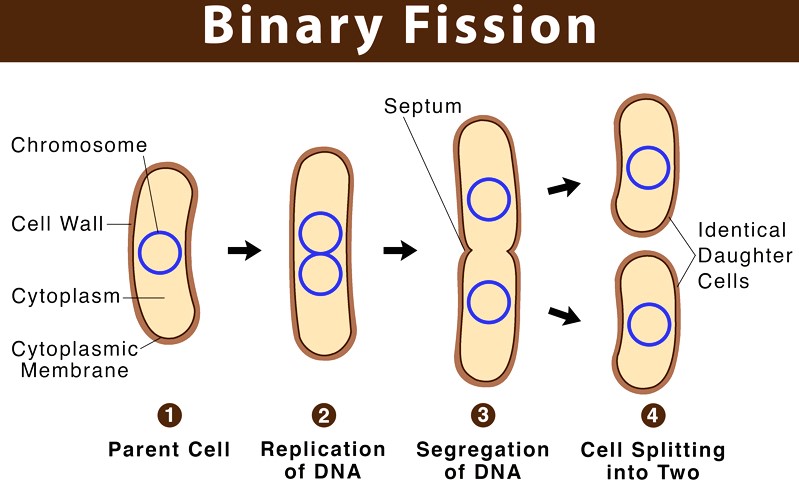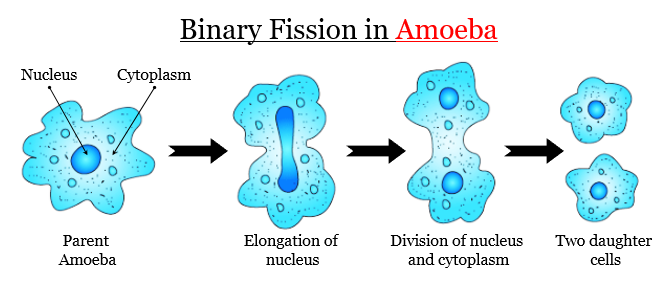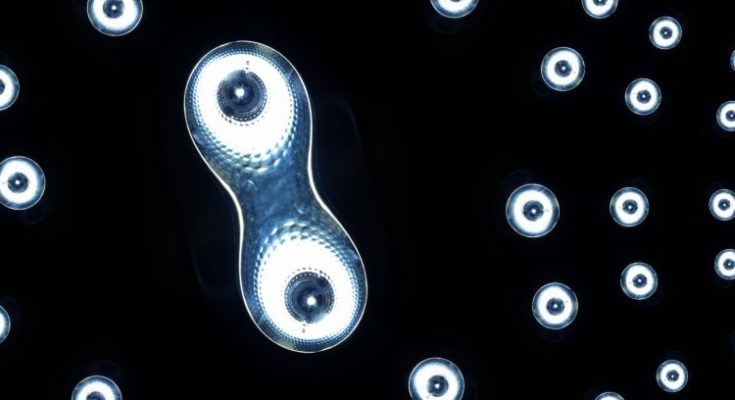Table of Contents
What Is Binary Fission ?
Binary fission is a type of Cell Division that is commonly used by single celled organisms, such as bacteria and protozoa to Reproduce. It is a process by which one cell divides into two identical daughter cells. This type of Reproduction is important for the survival and growth of many organisms as it allows for the rapid increase in population size.
Binary Fission – Definition
Binary Fission is a process of Asexual Reproduction in which a single cell divides into two identical daughter cells, each carrying one copy of the genetic material. This process allows the organism to produce genetically identical offspring, without the need for a mate or Sexual Reproduction.
Binary Fission is an important method of Reproduction for bacteria, archaea and many other single-celled organisms. It allows them to rapidly increase in number and colonise new environments.
Binary Fission is an important process in Cell Reproduction as it allows for the rapid increase in population size of single-celled organisms. Without this process these organisms would not be able to reproduce and survive in their respective environments.
Binary Fission occurs in several steps. First the cell duplicates its genetic material, creating two identical copies of its DNA. Next the cell elongates and the two copies of DNA move apart from each other to opposite ends of the cell. The cell then divides into two daughter cells, each with a copy of the genetic material. Finally, a new cell wall and membrane form around each daughter cell, resulting in two identical cells.
Also Check – What are the advantages of Sexual Reproduction over Asexual Reproduction
Steps of Binary Fission

Step 1- Replication of DNA
- The first step in Binary Fission is the Replication of the bacterium’s DNA. DNA Replication is the process by which a cell makes a copy of its DNA before cell division.
- In bacteria the circular Chromosome of the bacterium is replicated by a process called semi-conservative Replication.
- During this process the two strands of the DNA double helix are separated and each strand serves as a template for the synthesis of a new complementary strand. The end result is two identical copies of the original Chromosome.
Step 2- Growth of the Cell
- As the DNA replicates the bacterium begins to grow in size. It increases its cytoplasmic content and prepares for division by synthesising additional membrane and cell wall components. During this stage the two DNA strands migrate to opposite poles of the cell.
- During growth the bacterium synthesises new proteins, lipids and other molecules to increase its mass. This increase in mass is necessary to ensure that each Daughter Cell receives a copy of the replicated Chromosome and enough cytoplasmic content to carry out its cellular functions.
- The bacterium also synthesises new membrane and cell wall components to prepare for division. As the cell continues to grow the two copies of the replicated Chromosome migrate to opposite poles of the cell. This ensures that each Daughter Cell receives one copy of the Chromosome during division. Once the bacterium has reached a sufficient size it is ready to begin the next steps of Binary Fission.
Step 3- Segregation of DNA
- In this step the bacterium continues to elongate and a Septum begins to form at the midpoint of the cell. The Septum is a structure that divides the cell into two compartments and it is formed by the inward growth of the cell wall and membrane from opposite sides of the cell.
- As the Septum grows inward it eventually meets in the middle of the cell and divides it into two daughter cells. The two replicated Chromosomes are also separated during this phase with each copy moving towards the opposite poles of the cell. This ensures that each Daughter Cell receives one copy of the replicated Chromosome.
Step 4- Splitting of Cells
- In the final step of Binary Fission a new cell wall is formed at the division site. This new cell wall is synthesised by the daughter cells and fuses with the existing cell wall forming two separate bacterial cells. This process is called Cytokinesis.
- The cell splits at the centre, dividing the parent cell into two new daughter cells. Each of the daughter cells contains a copy of the replicated Chromosome as well as all the necessary organelles and Cellular Components. The two daughter cells are genetically identical to each other and to the parent cell.
- After division, the daughter cells may continue to grow and divide, repeating the process of Binary Fission.
- It’s important to note that the exact timing and duration of each step may vary depending on the species of bacteria and environmental conditions.
Also Check – How does Binary fission Differ from Multiple Fission ?
Examples of Binary Fission
Example 1- Binary fission in Bacteria

Binary Fission is the primary mode of Reproduction for Bacteria. Bacteria are Unicellular organisms that lack a nucleus and other membrane-bound organelles. The process of Binary Fission in bacteria is relatively simple and occurs in three main stages –
- Duplication of DNA- The circular Chromosome of the bacterium is replicated, creating two identical copies of the genetic material.
- Elongation of the cell- The cell elongates to accommodate the two copies of DNA.
- Separation of the two daughter cells- The cell membrane and cell wall grow inward, dividing the bacterium into two identical daughter cells.
The time it takes for bacteria to reproduce via Binary Fission varies depending on the species. Generally it can be as short as 20 minutes for some bacteria.
Example 1- Binary fission in Amoeba

Amoeba is a Unicellular organism that belongs to the kingdom Protista. It reproduces asexually by Binary Fission. The process of Binary Fission in amoeba is slightly different from that in bacteria and occurs in four main stages-
- Duplication of DNA- The nucleus of the amoeba duplicates its genetic material, creating two identical copies of the DNA.
- Elongation of the cell- The amoeba elongates to accommodate the two copies of DNA.
- Separation of the duplicated DNA- The two copies of DNA move towards opposite poles of the cell and a constriction forms in the middle of the cell.
- Separation of the two daughter cells- The cell membrane and cytoplasmic stream move towards the constriction, dividing the amoeba into two identical daughter cells.
The time it takes for an amoeba to reproduce via Binary Fission varies depending on the species and environmental conditions.
Advantages of Binary Fission
- Rapid Population Growth- Binary Fission is a fast and efficient method of reproduction that can result in rapid population growth. This is especially advantageous in favourable environments where resources are abundant and competition is low.
- Energy Efficiency- Binary Fission is a simple and energy-efficient method of reproduction as it does not require the formation of specialised reproductive cells or the expenditure of energy on courtship and mating behaviours.
- Clonal Reproduction- Binary Fission results in the production of identical daughter cells that means that the offspring are genetically identical to the parent. This can be advantageous in stable environments where the organism’s traits are well suited to its surroundings.
- Consistency of Traits- Since Binary Fission results in the production of Genetically identical offspring.It can be useful for maintaining consistent traits within a population.
- Efficient use of Resources- Binary Fission allows an organism to efficiently use available resources by dividing its biomass between two or more offspring. This can be especially important in environments where resources are limited or variable.
Also Check – 15 Important Differences between Unicellular and Multicellular organisms
Drawbacks of Binary Fission
- Lack of Genetic Diversity- In Binary Fission the parent cell divides into two identical daughter cells that means there is no mixing of genetic material. This results in very little genetic diversity. It can be a disadvantage in changing environments.
- Limited Adaptability- Since Binary Fission only results in the formation of identical daughter cells. The organism’s ability to adapt to changing conditions is limited. In contrast sexual reproduction allows for the creation of diverse offspring increasing the likelihood that some will have advantageous traits for survival.
- Accumulation of Mutations- Since Binary Fission is a form of asexual reproduction any mutations that arise in the parent cell are passed down to the daughter cells without any chance for correction through Recombination. This can lead to an accumulation of harmful mutations over time.
- Population Saturation- Binary Fission can result in rapid population growth, which can quickly lead to overcrowding and competition for resources. This can lead to a decrease in the organism’s fitness and survival.
- Vulnerability to Environmental Stress- Binary Fission is a simple and efficient method of Reproduction, but it can also make the organism vulnerable to environmental stress. For example if conditions become unfavourable the organism may not be able to respond quickly enough to prevent damage to its population.
- Limited Evolution- Since Binary Fission does not introduce new genetic material the rate of evolution can be slow compared to sexual reproduction. This can limit an organism’s ability to adapt to new environments or changing conditions.
Also Check – 9 Important Differences between Sexual and Asexual Reproduction
Frequently Asked Questions On Binary Fission
- What is Binary Fission and how is it different from Sexual Reproduction?
- Which organisms commonly use Binary Fission as a method of reproduction?
- What are the steps involved in Binary Fission?
- How does DNA replication occur during Binary Fission in bacteria?
- Why is the growth stage important during Binary Fission?
- What is the purpose of the septum during Binary Fission?
- How is cytokinesis involved in Binary Fission?
- Can you explain the importance of Binary Fission for single-celled organisms?
- How long does it typically take for bacteria to reproduce via Binary Fission?
- Are there any variations in the timing and duration of the steps involved in Binary Fission?
- How does Binary Fission differ between Amoeba and Bacteria?
- What are the advantages of Binary Fission?
- How does Binary Fission allow for rapid population growth?
- How does Binary Fission result in clonal reproduction?
- What is the benefit of clonal reproduction in stable environments?
- How does Binary Fission allow for the maintenance of consistent traits within a population?
- How does Binary Fission efficiently use available resources?
- What are the drawbacks of Binary Fission?
- What is the disadvantage of the lack of genetic diversity in Binary Fission?
- How is an organism’s ability to adapt to changing conditions limited in Binary Fission?
- What is the consequence of the accumulation of mutations in Binary Fission?
- How can Binary Fission make an organism vulnerable to environmental stress?
- What are the limitations of Binary Fission in terms of an organism’s ability to adapt to new environments or changing conditions?
Also Check – How do Organisms Reproduce Class 10 -Notes
Also Check – How do Organisms Reproduce Class 10 Questions and Answers


4 Comments on “Binary Fission”